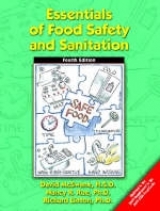
The Essentials of Food Safety and Sanitation
Pearson (Verlag)
978-0-13-064844-0 (ISBN)
- Titel erscheint in neuer Auflage
- Artikel merken
A fundamental overview of all the factors that affect the wholesomeness of food from its inception to the time it is eaten. Essentials of Food Safety and Sanitation, Updated 3rd Edition is based on the Food Code and is designed to serve as a workplace reference guide to safe food handling procedures. This book will serve as an effective learning tool for any food handling facility from supermarkets to care centers to restaurants. Use this book to prepare for any one of the national certification exams or as a teaching tool for training everyone on the basics of food safety. Also available in Spanish!
David Z. McSwane, H.S.D., REHS, CFSP, is an Associate Professor of Public and Environmental Affairs at Indiana University. He has over 25 years of experience in food safety and sanitation working in state and local regulatory agencies and as a consultant to the food industry. Dr. McSwane has published numerous articles and presented papers on a variety of subjects related to food safety. Dr. McSwane is a nationally recognized trainer in food safety and sanitation. He has taught courses at the university level and for regulatory agencies, food establishments, food industry trade associations, vocational schools, and environmental health associations throughout the United States. Dr. McSwane is a recipient of the Walter S. Mangold award. This is the highest honor bestowed by the National Environmental Health Association. He has been a correspondent for the Food Protection Report and is a member of the Environmental and Public Health Council at Underwriters Laboratories Inc. and the National Automatic Merchandising Association's Health Industry Council. Nancy Roberts Rue, Ph.D., R.N., has a background in teaching in technical education. Her doctorate is in educational leadership and curriculum and instruction from the University of Florida. With thirty years of experience in higher education and evaluation at Indiana University and St. Petersburg Junior College, she is dedicated to the task of building educational materials that meet the needs of those who want to learn. Dr. Rue wrote the Handbook for Safe Food Service Management while serving as director of the Certified Professional Food Manager program at National Assessment Institute. The Handbook was designed to give entry level food managers a single source for study and focused on need-to-know information. She is now an independent writer and consultant on training and development techniques. Richard Linton, Ph.D., is an Associate Professor of Food Safety at Purdue University. His expertise is in the development and implementation of food safety and food quality programs, specifically in Hazard Analysis Critical Control Point (HACCP) systems. Dr. Linton spent twelve years working in retail food establishments. In recent years, he has educated food workers and managers from all segments of the industry throughout the nation and the world. Dr. Linton has developed several different types of food safety training programs for retail food managers and workers. He also works closely with the retail food industry on research projects that help improve the quality and safety of the food they serve. There are several reference books available in the field of food safety. However, most of these resources are directed toward a particular type of food establishment. The authors of Essentials of Food Safety and Sanitation believe there is need for a text that applies food safety principles to all food establishments, regardless of type. Chapter 4, The Flow of Food, is the focal point. It clearly defines the important strategies for handling food, from receiving until it is placed in the hands of the consumer. Chapter 5 follows with a comprehensive description about how to apply the Hazard Analysis Critical Control Point (HACCP) system to the process. The authors wish all readers continued success in their food safety and sanitation activities. Regardless of where you work, you must always remember—foodborne illness is a preventable disease. Follow the basic rules of food safety and head for a satisfying career in the food industry.
1. Food Safety and Sanitation Management.
2. Hazards to Food Safety.
3. Factors that Affect Foodborne Illnesses.
4. Following the Food Product Flow.
5. The Hazard Analysis Critical Control Point (HACCP) System.
6. Facilities, Equipment, and Utensils.
7. Cleaning and Sanitizing Operations.
8. Environmental Sanitation and Maintenance.
9. Accident Prevention and Crisis Management.
10. Education and Training.
11. Food Safety Regulations.
| Erscheint lt. Verlag | 16.10.2002 |
|---|---|
| Sprache | englisch |
| Gewicht | 654 g |
| Themenwelt | Schulbuch / Wörterbuch |
| ISBN-10 | 0-13-064844-2 / 0130648442 |
| ISBN-13 | 978-0-13-064844-0 / 9780130648440 |
| Zustand | Neuware |
| Haben Sie eine Frage zum Produkt? |
aus dem Bereich



